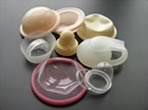|
RECENT NEWS
The United States Food and Drug Administration reclassified the female condom and changed the name to the internal condom. Read the September 2018 rule here.
Global Female Condom Day is September 16!

Caya (SILCS) diaphragm is available in the United States by prescription. Learn more here.
Reflexions Flat Spring Diaphragm has been discontinued by the manufacturer. Read more here.
Caya diaphragm approved for OTC sale in Canada. Read more here.
|
|
The Cervical Barrier Advancement Society (CBAS) aims to raise the profile of cervical barrier methods, including diaphragms, caps, female condoms, and other devices, and to share the latest information and resources related to these methods.
What are cervical barriers?
 Most people think of cervical barriers primarily as the diaphragm and cervical cap, but the category also encompasses female and male condoms, the sponge, and microbicides, among others. Cervical barriers are physical or chemical substances that prevent pregnancy and in some cases reduce the spread of STIs, including HIV. They do not include hormonal contraceptive methods. For more information about the range of cervical barrier methods, see Cervical Barrier Methods. Most people think of cervical barriers primarily as the diaphragm and cervical cap, but the category also encompasses female and male condoms, the sponge, and microbicides, among others. Cervical barriers are physical or chemical substances that prevent pregnancy and in some cases reduce the spread of STIs, including HIV. They do not include hormonal contraceptive methods. For more information about the range of cervical barrier methods, see Cervical Barrier Methods.
CBAS Diaphragm and Cervical Cap and Female Condom Bibliographies
Our bibliographies of the literature on diaphragms and cervical caps and on the internal/female condom include peer-reviewed, published articles (updated through March 1, 2020). Both bibliographies can be downloaded by following the links below.
Diaphragm and cervical cap bibliography
Internal/female condom bibliography
MIRA Diaphragm Trial Results
The Methods for Improving Reproductive Health in Africa (MIRA) trial found no significant difference in the rate of new HIV infections between women who received the diaphragm plus lubricant along with male condoms and those who only received male condoms. Therefore, the results do not support the addition of the diaphragm to current HIV prevention strategies. To date, condoms remain the only proven barrier method for HIV prevention. This means there is still an urgent need for continued investment and research into current and new HIV prevention methods that give women and girls the power to protect their health. Read more...
Click here for the MIRA Key Findings and Publications brief updated in June 2011.
Why is research on cervical barriers important?
 Sister Kamba works on diaphragm research in Zimbabwe |
|
|


